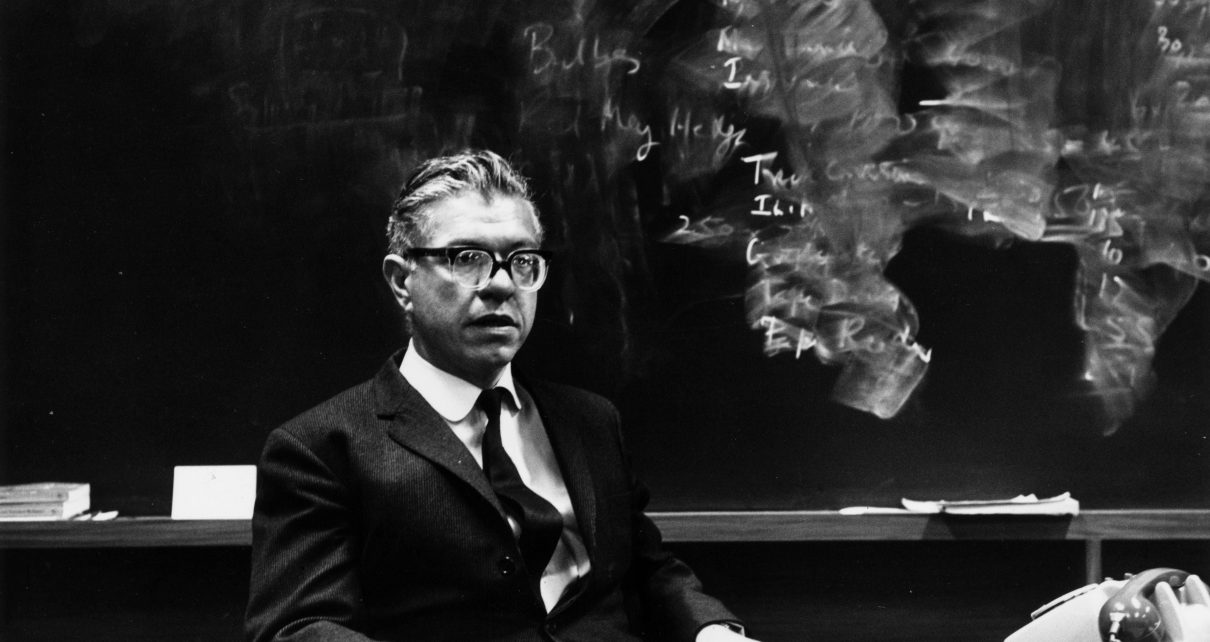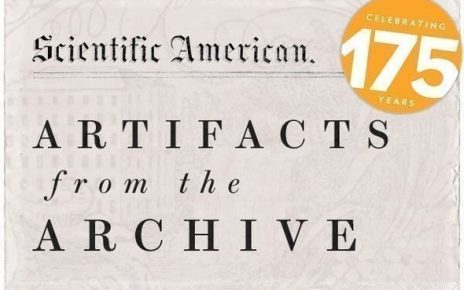The recent deaths of Freeman Dyson, Philip Anderson and Margaret Burbidge have stirred up memories of other giants of physics. I’m posting profiles of some of these characters in the hope that readers will find them interesting and relevant to current scientific controversies. They might also provide a distraction from coronavirus coverage. Below is an edited version of a portrait of Fred Hoyle, the iconoclastic British astrophysicist, who collaborated with Burbidge, from my 1996 book The End of Science. I interviewed Hoyle in 1992 at his home in England. – John Horgan
A selective reading of Fred Hoyle’s resume might make him appear to be the quintessential scientific insider. Born in 1915, Hoyle studied at the University of Cambridge under physicist and Nobel laureate Paul Dirac. Their partnership worked well, Hoyle once said, since he didn’t want a mentor and Dirac didn’t want to be one. Hoyle became a lecturer at Cambridge himself in 1945, and he swiftly moved to the forefront of astronomy, showing how nuclear physics could illuminate such celestial phenomena as white dwarfs, red giants, supernovae and the brilliant radio sources that came to be called quasars.
In 1953 Hoyle’s investigations of how stars generate heavy elements led him to predict the existence of a previously unknown state of the isotope carbon 12. Shortly thereafter, the physicist William Fowler performed experiments that confirmed Hoyle’s prediction. Hoyle’s work on stellar nucleosynthesis culminated in a 1957 paper, written with Fowler and Geoffrey and Margaret Burbidge, that remains a milestone in modern astrophysics. Even Hoyle’s critics think he deserved to share the Nobel Prize that Fowler received in 1983 for this research.
Hoyle founded the prestigious Institute of Astronomy at Cambridge in the early 1960’s and served as its first director. For these and other achievements he was knighted in 1972. Yes, Hoyle is Sir Fred. Yet Hoyle’s stubborn refusal to accept the big bang theory–and his adherence to fringe ideas in other fields–made him an outlaw in the field he had helped to create.
Since 1988, Hoyle has lived in a high-rise apartment building in Bournemouth, a town on England’s southern coast. When I visited him there in 1992, his wife Barbara let me in and took me into the living room, where I found Hoyle sitting in a chair watching a cricket match on television. He rose and shook my hand without taking his eyes off the match. His wife, gently admonishing him for his rudeness, went over to the TV and turned it off. Only then did Hoyle, as if waking from a spell, turn his full attention to me.
I expected him to be odd and embittered, as many mavericks are, but he was, for the most part, quite amiable. With his pug nose, jutting jaw and penchant for slang–colleagues were “chaps” and a bad theory was a “bust flush”–he exuded a kind of blue-collar integrity and geniality. He reveled in the role of outsider. “When I was young the old regarded me as an outrageous young fellow, and now that I’m old the young regard me as an outrageous old fellow.” He chuckled. “I should say that nothing would embarrass me more than if I were to be viewed as someone who is repeating what he has been saying year after year” as many astronomers do. “What I would be worried about is somebody coming along and saying what you’ve been saying is technically not sound. That would worry me.”
Hoyle first started thinking seriously about the origin of the universe shortly after World War II during long conversations with physicists Thomas Gold and Herman Bondi. “Bondi had a relative somewhere–he seemed to have relatives everywhere–and one sent him a case of rum,” Hoyle recalled. While imbibing Bondi’s booze, the three physicists turned to a perennial puzzle of the young and intoxicated: How did we come to be?
The finding that all galaxies in the cosmos are receding from one another had convinced many astronomers that the universe had exploded into being at a specific time in the past and was still expanding. Hoyle’s fundamental objection to this model was philosophical. It did not make sense to talk about the creation of the universe unless one already had space and time for the universe to be created in. “You lose the universality of the laws of physics,” Hoyle explained to me. “Physics is no longer.” The only alternative to this absurdity, Hoyle decided, was that space and time must have always existed. He, Gold and Bondi thus invented the steady state theory, which posited that the universe is infinite both in space and time and constantly generates new matter through some still-unknown mechanism.
Hoyle stopped promoting the steady-state theory after the discovery of the microwave background radiation in the early 1960’s seemed to provide conclusive evidence for the big bang. Theorists had predicted that the big bang would produce a microwave afterglow. But his old doubts resurfaced in the 1980’s as he watched cosmologists struggle to explain the formation of galaxies and other puzzles. “I began to get the sense that there was something seriously wrong,” not only with these new concepts, he said, but with the big bang itself. “I’m a great believer that if you have a correct theory, you show a lot of positive results. It seems to me that they’d gone on for 20 years, by 1985, and there wasn’t much to show for it. And that couldn’t be the case if it was right.”
Hoyle thus resurrected his old steady state theory in a new and improved form. Rather than one big bang, he said, there were many little bangs occurring in pre-existing space and time. These little bangs are responsible for light elements and the red shifts of galaxies. As for the cosmic microwave background, Hoyle’s best guess was that it is radiation emitted by some sort of metallic interstellar dust. Hoyle acknowledged that his “quasi-steady state theory,” which in effect replaces one big miracle with many little ones, is far from perfect. But he insisted that recent versions of the big bang theory, which posit the existence of inflation, dark matter and other exotica, are much more deeply flawed. “It’s like medieval theology,” he exclaimed in a rare flash of anger.
The longer that Hoyle spoke, however, the more I began to wonder if he sincerely doubted the big bang. In some of his statements, he revealed a proprietary fondness for the theory. One irony of modern science is that Hoyle coined the term “big bang” in 1950 while he was doing a series of radio lectures on astronomy. Hoyle told me that he meant not to disparage the theory, as many accounts have suggested, but merely to describe it. At the time, he recalled, astronomers often referred to the theory as “the Friedman cosmology,” after a physicist who showed how Einstein’s theory of relativity gave rise to an expanding universe.
“That was poison,” Hoyle declared. “You had to have something vivid. So I thought up ‘the big bang.’ If I had patented it, copyrighted it…” he mused. The August 1993 Sky and Telescope magazine initiated a contest to rename the theory. After mulling over thousands of suggestions, the judges announced they could find none worthy of supplanting “big bang.” Hoyle was not surprised. “Words are like harpoons,” he commented. “Once they go in, they are very hard to pull out.”
Hoyle also seemed obsessed with how close he had come to discovering the cosmic microwave background. It was 1963, and during an astronomy conference Hoyle fell into a conversation with Robert Dicke, a physicist who was planning to search for the cosmic microwaves predicted by the big bang model. Dicke told Hoyle that he expected the microwaves to be about 20 degrees above absolute zero, which is what most theorists were predicting. Hoyle then told Dicke that in 1941 the Canadian radio astronomer Andrew McCullough had found interstellar gas radiating microwaves at three degrees, not 20.
To Hoyle’s everlasting regret, neither he nor Dicke spelled out the implication of McCullough’s finding: that the microwave background might be three degrees. “We just sat there drinking coffee,” Hoyle remembered, his voice rising. “If either of us had said, ‘Maybe it is three degrees,’ we’d have gone straightaway and checked it, and then we’d have had it.” A year later, just before Dicke turned on his microwave experiment, Arno Penzias and Robert Wilson of Bell Laboratories discovered the three-degree microwave radiation, an achievement for which they received the Nobel prize. “I’ve always felt that was one of the worst misses of my life,” Hoyle sighed, shaking his head slowly.
Why should Hoyle care that he had nearly discovered a phenomenon that he now derided as illusory? I think Hoyle, like many mavericks, once hoped to be a member of the inner circle of science, draped in honor and glory. He went far toward realizing that goal. But in 1972, officials at Cambridge forced Hoyle to resign from his post as director of the Institute for Astronomy–for political rather than scientific reasons. Hoyle and his wife left Cambridge for a cottage on an isolated moor in northern England, where they lived for 15 years before moving to Bournemouth. During this period Hoyle’s anti-authoritarianism, which always served him well, became less creative than reactionary, but he still dreamed of what might have been.
Hoyle suffered from another problem. The task of the scientist is to find patterns in nature. There is always the danger that you will see patterns where there are none. Hoyle, in the latter part of his career, seemed to have succumbed to this pitfall. He saw patterns—and even conspiracies–in the very structure of the cosmos and among those scientists who rejected his radical views.
Hoyle’s mindset is most evident in his views on biology. Since the early 1970’s he has argued that the universe is pervaded by viruses, bacteria and other organisms. (Hoyle first broached this possibility in 1957 in The Black Cloud, which remains the best known of his many science fiction novels.) These space-faring microbes supposedly provided the seeds for life on earth and spurred evolution thereafter; natural selection played little or no role in creating the diversity of life. Hoyle has also asserted that epidemics of influenza, whooping cough and other diseases are triggered when the earth passes through clouds of pathogens.
Discussing the biomedical establishment’s continued belief in the more conventional, person-to-person mode of disease transmission, Hoyle glowered. “They don’t look at those data and say, ‘Well, it’s wrong,’ and stop teaching it. They just go on doping out the same rubbish. And that’s why if you go to the hospital and there’s something wrong with you, you’ll be lucky if they cure it.”
But if space is swarming with organisms, I asked, why haven’t they been detected? Oh, but they probably were, Hoyle assured me. He suspected that U.S. experiments on high-altitude balloons and other platforms turned up evidence of life in space in the 1960’s, but officials hushed it up. Why? Perhaps for reasons related to national security, Hoyle suggested, or because the results contradicted received wisdom. “Science today is locked into paradigms,” he intoned solemnly. “Every avenue is blocked by beliefs that are wrong, and if you try to get anything published by a journal today, you will run against a paradigm and the editors will turn it down.”
Hoyle emphasized that, contrary to certain reports, he did not believe the AIDS virus came from outer space. It “is such a strange virus I have to believe it’s a laboratory product,” he said. Was Hoyle implying that the pathogen might have been produced by a biological-warfare program that went awry? “Yes, that’s my feeling,” he replied.
Hoyle also suspected that life and indeed the entire universe must be unfolding according to some cosmic plan. The universe is an “obvious fix,” Hoyle said. “There are too many things that look accidental which are not.” When I asked if Hoyle thought some supernatural intelligence is guiding things, he nodded gravely. “That’s the way I look on God. It is a fix, but how it’s being fixed I don’t know.”
Many of Hoyle’s colleagues–and a majority of humanity–share his view that the universe is, must be, a divine conspiracy. Perhaps it is. Who knows? But his assertion that scientists would deliberately suppress evidence of microbes in outer space or of genuine flaws in the expanding universe model reveals a fundamental misunderstanding of his colleagues. Most scientists yearn for such revolutionary discoveries.
Will Hoyle’s skepticism toward the big bang ever be vindicated? Will cosmology undergo a paradigm shift that leaves the big bang behind? Probably not. The theory rests on three solid pillars of evidence: the red shift of galaxies, the microwave background and the abundance of light elements, which were supposedly synthesized during our universe’s fiery birth. The big bang also does for cosmology what evolution does for biology: it provides cohesion, meaning, a unifying narrative. That is not to say that the big bang can explain everything, any more than evolutionary theory can. The origin of life remains profoundly mysterious, and so does the origin of the universe. Nor can physics tell us why our universe takes its specific form, which allowed for our existence.
In the future, new observations will surely force cosmologists to tweak the big bang theory. [See Postscript.] But just as Darwinian theory has endured in spite of countless revisions, so will the big bang theory—not, as Hoyle claimed, because science is “locked into paradigms,” but because it is true.
Postscript: In the late 1990’s astrophysicists discovered that the universe is expanding at an increasing rate. This is the most significant finding in cosmology—and arguably science as a whole—over the last 25 years. But the big bang theory has absorbed this finding, just as evolutionary theory absorbed the discovery of the double helix.
Further Reading:
Scientific Rebel Freeman Dyson Dies
Philip Anderson, Gruff Guru of Physics and Complexity Research, Dies
Science Will Never Explain Why There’s Something Rather Than Nothing
Was I Wrong about The End of Science?
See also my free, online book Mind-Body Problems: Science, Subjectivity & Who We Really Are.




